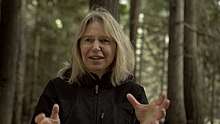Suzanne Simard
Suzanne Simard is a professor of forest ecology and teaches at the University of British Columbia.

She is a biologist and has tested theories about how trees communicate with other trees. She used radioactive carbon to measure the flow and sharing of carbon between individual trees and species, and discovered that birch and Douglas fir share carbon. Birch trees receive extra carbon from Douglas firs when the birch trees lose their leaves, and birch trees supply carbon to Douglas fir trees that are in the shade.
Mother Trees
Simard helped identify something called a hub tree, or “mother tree”. Mother trees are the largest trees in forests that act as central hubs for vast below-ground mycorrhizal networks. A mother tree supports seedlings by infecting them with fungi and supplying them the nutrients they need to grow.[1]
She discovered that Douglas Firs provide carbon to baby firs. She found that there was more carbon sent to baby firs that came from that specific mother tree, than random baby firs not related to that specific fir tree. It was also found the mother trees change their root structure to make room for baby trees.
Interspecies Cooperation
Simard found that "fir trees were using the fungal web to trade nutrients with paper-bark birch trees over the course of the season".[2] For example, tree species can loan one another sugars as deficits occur within seasonal changes. This is a particularly beneficial exchange between deciduous and coniferous trees as their energy deficits occur during different periods. The benefit "of this cooperative underground economy appears to be better over-all health, more total photosynthesis, and greater resilience in the face of disturbance".[2]
Science Communication
Suzanne Simard is an advocate of Science Communication. At the University of British Columbia she initiated with colleagues Dr. Julia Dordel and Dr. Maja Krzic the Communication of Science Program TerreWEB,[3] which has been training graduate students to become better communicators of their research since 2011. Simard has appeared on various non-science platforms and media, such as the short documentary Do trees communicate,[4] three TED (conference) talks [5][6][7] and the documentary film Intelligent trees,[8] where she appears alongside forester and author Peter Wohlleben.
Popular Culture
Simard’s work is referenced in Richard Powers’ 2018 novel The Overstory, in which a character named Patricia Westerford pioneers the controversial idea that trees can communicate with each other. She is ridiculed by fellow scientists, but eventually is vindicated.
References
- "Prof. Suzanne Simard talks about "Mother Trees"". 16 May 2011.
- "The Intelligent Plant".
- "TerreWEB". terreweb.ubc.ca.
- "Do Trees Communicate?" – via www.imdb.com.
- "How trees talk to each other".
- "The networked beauty of forests - Suzanne Simard". TED-Ed.
- "Nature's internet: how trees talk to each other in a healthy forest – TEDxSeattle". tedxseattle.com.
- "Intelligent Trees - The Documentary".
External links
- Suzanne Simard: How trees talk to each other | TED Talk 2016-07-22 – Introduction video explaining her findings
- “Mother Trees” Use Fungal Communication Systems to Preserve Forests
- Official Trailer "Intelligent Trees" featuring Suzanne Simard and Peter Wohlleben